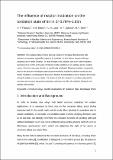The influence of reactor irradiation on the oxidation state of tin in Zr-0.76Fe-1.6Sn
Author(s)
Filippov, Vladimir P; Bateev, A. B.; Lauer, Yu. A.; Dykhuis, Andrew F; Short, M.P.
Download10751_2017_1487_ReferencePDF.pdf (730.0Kb)
Open Access Policy
Open Access Policy
Creative Commons Attribution-Noncommercial-Share Alike
Terms of use
Metadata
Show full item recordAbstract
The oxidation states of minor alloying elements in Zircaloys often determine their resistance to corrosion, especially in nuclear reactors. In particular, tin is of interest because of its near ubiquitous use in earlier Zircaloys. To study changes in the oxidation state of tin under irradiation, specimens of Zr-0.76Fe-1.6Sn were corroded at similar conditions in an autoclave and in a nuclear reactor. Corrosion rates were found to be significantly accelerated following irradiation compared to those in the autoclave. Mössbauer spectroscopy revealed that in both the autoclave conditions and reactor conditions, a combination of tetravalent, divalent, and elemental (β-Sn) tin particles are formed during the initial corrosion processes. The kinetics of both the change in tin oxidation state and the corrosion rate in-reactor are greatly accelerated, pointing to the effect of irradiation driving tin into solution more quickly.
Date issued
2018-02Department
Massachusetts Institute of Technology. Department of Nuclear Science and EngineeringPublisher
Springer International Publishing
Citation
Hyperfine Interactions. 2018 Feb 26;239(1):21
Version: Author's final manuscript